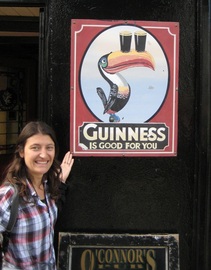
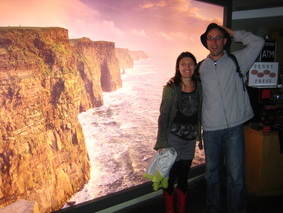
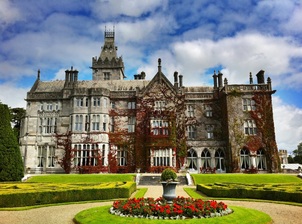
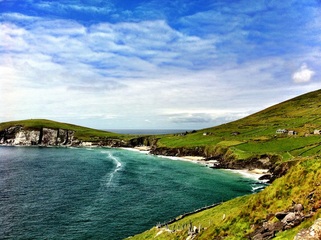
To see the pics of Southern Ireland click here:
To see the pics of Kastellaun click here:
The following story will resonate with some of you more than others. Flying out of the London airport a few weeks back, I walked by a store that had the new Kindle Touch for 99 GBP(about $155), less than I remembered seeing advertised on the UK Amazon site. I had been thinking about getting an e-reader for our travels so I decided to just go ahead and buy it without the usual research...a rare act of shopping spontaneity on my part! But that night, once we had internet again, I checked the US Amazon site and found that the Kindle (with some unobtrusive advertisements) could be had for only $99. I immediately had buyer’s remorse and thought that maybe I should just carry the kindle in its packaging until we flew out of Dublin, where another of the same store would let me return it. So I went through the arguments in my head. By having the Kindle now I can test it out without having family ship it from America, which is a pain for them anyway. Also Neda and my mother-in-law Nadia might want one as well and this would give them a chance to look at it without shipping it overseas first. I decided I would just keep the Kindle and not worry about returning it just to save a few dollars.  My spiritual mentor ;) But as our trip continued through the UK and Scotland, I still hadn’t opened the Kindle and had brought the question up to Neda several times as to whether I should keep it or not. Even though I had made the decision and reviewed the pros and cons, I was still having trouble letting go of the fact that the Kindle could have been had for about $55 less. Finally, in Galway in Southern Ireland, when I brought it up one more time to Neda, she said something very wise to me. She said, “Sweetie, why don’t you just make that $55 your spiritual practice. Consider it a payment for learning to let go of the other possibilities that are torturing you and to accept what is.” What sage advice from my spiritual partner! It is so important to find those situations in our lives that we have difficulty accepting and practice with them. In this case, the actual situation was as close to meaningless as possible and I was still making myself suffer over it!  The best view we had of Moher Further opportunities for acceptance were provided throughout Southern Ireland with what is sometimes a traveler’s bane and sometimes an ally: the weather! As we traveled south from Derry to the port city of Galway, the clouds darkened. Our day trip to the Aran Islands was cold with intermittent spitting rain the whole time. The next day we headed to the Cliffs of Moher, where an enduring fog made this our best picture! We only had one day to see this wonder of the natural world, but the weather just didn’t want to cooperate. We could rage against the situation, but nothing would change in the end. Only accepting the situation would release us from the suffering of what could have been. I do understand that there are friends and family in our lives struggling to accept much more difficult situations than paying a bit too much for an electronic device or having bad weather. For them the issue of acceptance is even more difficult, though I think ultimately it is still the only path to relief from suffering.  Adare Manor was stunning Luckily, Southern Ireland didn’t continue to test our acceptance of inclement weather. Instead, as we traveled down to Limerick to visit Iain’s friend Irina, the weather took a turn for the better. Irina, a local in Limerick for the past 12 years, generously took us to the best sites the region had to offer. On the first day we hiked through the Gap of Dunloe, enjoyed amazing views of the Ring of Kerry, and had a pint in the tidy town of Killarney. We also visited the beautiful gardens at Muckross House (set within Killarney National Park) and had lunch overlooking a ruined castle.  The blaskets on the edge of Dingle The next day we visited the beautiful Dingle peninsula, which has sweeping views of distant isles, hidden beaches, and the friendliest dolphin in history. Fungie, the Dingle dolphin, has lived in the bay of Dingle for nearly 30 years. While most dolphins migrate to warmer waters during the winter, Fungie enjoys the attention of the tourists too much and stays in Dingle the whole year (he is not fed by humans or domesticated in any way). It was a lot of fun to spot him popping out of the water to greet us as we cruised around the harbor. Unfortunately, the company running the tour puts 4-5 boats in the water at once during high season, limiting how much Fungie can do. But Irina’s friend caught this video of Fungie really performing when just one boat was out this past winter. After Dingle, Irina helped us make up for not seeing the Cliffs of Moher by taking us to Ballybunnion, where the local cliffs and rock formations are spectacular and completely non-touristic. We left Southern Ireland for a short stopover in Hahn, Germany, where we visited the cute town of Kastellaun for some Germany beers, a ruined castle and a beautiful hike through the local woods. Now we head back to Bulgaria and wait for our friends Christie & Brett to arrive so we can pay the hospitality forward with a tour of our country! To see the pics of Southern Ireland click here: To see the pics of Kastellaun click here: in memorium
0 Comments
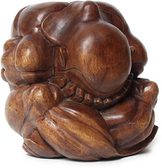 The weeping Buddha is an iconic sculpture in Buddhist art. It is often carved by journeymen wood carvers from a single piece of wood to prove their mastery of the craft. Though there are various explanations as to its meaning, I have always believed that this weeping figure cries for the overwhelming suffering he sees in the world. It has always been a poignant image for me and it was on my mind as we traveled through Northern Ireland. But first things first - we traveled to Northern Ireland via a flight to Dublin. In our one day stopover, Jeff loaded up on passport pages at the US embassy and we spent a pleasant day at the Guinness Storehouse, a museum of Guinness brewing, history, and marketing. We also took a brief course in pouring the “perfect pint” and as luck would have it, some Jehovah’s Witnesses gave us their free beer tickets at the end of the tour…which almost made us miss our bus to Northern Ireland! 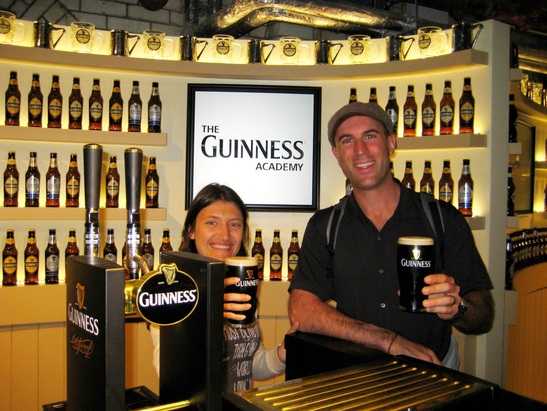
Neda & Jeff learn to pour the perfect pint of Guinness...I learned that a draught of Guinness is infused with 80% nitrogen and 20% carbon dioxide at the tap - which is what gives it the creamy head and flavor. This wasn't invented until the 1950's, however, so before that a Guinness would be much more like a regular stout beer...
In the end some lucky tram timing got us into Londonderry (Derry according to some) on time. Northern Ireland, which is a separate country from the Republic of Ireland and is part of the UK, was a lesson in contrasts for us that can’t be understood without some brief history. It begins in earnest around the early 1600’s. A group of Irish earls fled the country (for reasons still debated) and their estates were quickly confiscated by the Crown. To secure the area for English (and Protestant rule), King James I (VI of Scotland) establishes a plantation scheme whereby the land is to be settled by low-land Scottish raiders living along the English border that he had banished for their crimes. James was tired of the constant border raids of these families and thought that he could solve two problems at once. He could force the migration of the raiders to relieve the troubles along the Scotland-England border while also spreading Protestantism and English rule to the predominantly Catholic population there. The raiders were joined by a plethora of other Scots and some English looking to flee harsh economic times in their countries. 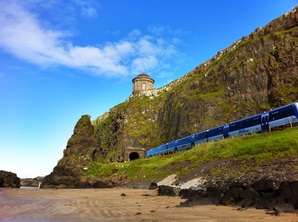 Mussenden Temple near Derry Though the plantation system would eventually repress the native Catholics and lead to the loss of their land, it should be noted that the English Lord in charge of implementing the plantation, Arthur Chichester, thought that an equitable distribution of land to the native Irishmen and incoming Protestants would reconcile the locals to English rule. However, it only took one mishap to tip the scales towards inequality. One of the last remaining Irish earls named Cahir O’Doherty (who was actually an ally of the English in the 9 Years War) was punched in the face by the new governor of Derry George Paulet during an argument. This prompted O’Doherty to seek revenge by burning Derry and starting a rebellion. The rebellion was quashed and with it any chance for equitable distribution. Fearing the local population, King James ensured that Protestants received the lion’s share of the land, sowing dissent permanently into the native Irish population. This was compounded by the exile of all Catholic priests from the area in an attempt to convert the population to Protestantism. It is amazing how one punch can change the course of history. The plantation era in English-Ireland relations was not restricted to Ulster – if you are interested in more of the history you can read about it here. This oppressive situation continued until 1641 when the native Catholics staged another rebellion and brutally attacked the Protestant landowners and their families. This act of violence was met in kind by the enraged Protestants of Ulster and the cycle had begun. The next 400 years would be a continuing battle between protestants and Catholics, culminating in the late 1960’s with the beginning of what they call “The Troubles”. The troubles were a time of increased militant action between paramilitary groups like the Irish Republican Army (which wanted to see a united Ireland with no influence from the British Crown) and the loyalist Ulster Volunteer Force, who wished to defend their right to stay a part of the UK and to be Protestant ruled. After over 30 years of fighting, a truce was made with the Belfast agreement of 1998. Our experience was that while much of the paramilitary activity has subsided in Northern Ireland due to this truce, the tribal division between the two groups of people was still starkly evident. 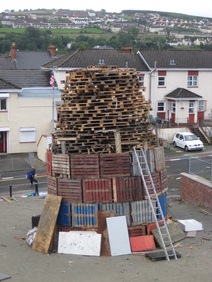 Preparing the bonfire for 11th eve As we traveled through the North, various towns would be coated with either loyalist colors (the red, white, and blue of the United Kingdom Union Jack flag and the Flag of Ulster) or the nationalist colors of the Republic of Ireland (green, white, and orange). Even today, if boys living in a Protestant enclave near the center of Derry wander too far from their homes, they are swiftly given a beating by the Catholics surrounding them. We happened to be in the country on the 12th of July, a holiday where Protestants celebrate the victory of William of Orange over King James II at the Battle of the Boyne. This victory essentially sealed protestant rule over Northern Ireland. The evening of the 11th is marked by an enormous amount of massive bonfires lit by the Protestant population all over the country (we went to 3 alone in a little neighborhood outside Derry). The day of the 12th is then followed by talented marching bands touting the orange colors and Ulster Flag as they march through Catholic and Protestant neighborhoods, celebrating a victory that divided their country 400 years ago and left the native population as 2nd class citizens. 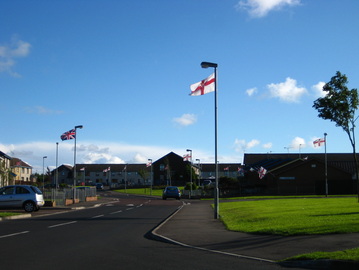 Partisan flags fly in most neighborhoods As I watched this parade, the image of the weeping Buddha was strong in my mind. I could see him crying at the terrible suffering that both sides of this battle had endured. Long ago this conflict stopped being about who is wrong and who is right as the vicious cycle of violence followed by revenge played out over and over. The hardcore Catholics side was unwilling to forget the way their land was occupied and accept that the Protestants are a legitimate part of their country now. The hardcore Protestants were terrified that a Catholic majority will lead to them becoming 2nd class citizens out of revenge. While the Belfast Agreement has led to non-violent power sharing for the last 15 years, the sectarian separation between the people of Northern Ireland has not abated. While all of this conflict and hatred can seem overwhelming, our experience in Northern Ireland was still defined by smiling Buddhas more so than weeping ones. Our friend Iain (who Neda had only met once before we came to see him in Derry) planned a whole 4 day itinerary for us while we were in his country. He and his family graciously invited us to stay in their home as we traveled to the geological wonders of the Giant’s Causeway and the Marble Arch Caves. Iain’s friend Alex took us on a wonderful tour of the city walls of Derry, fielded all my questions about the history of the region, and even served us a delicious high tea. Random folks at the pubs bought us pints of Guinness and welcomed us to their country. It was clear that the kindness of human nature was still shining through in Northern Ireland, despite the fog of division that rested over the country. 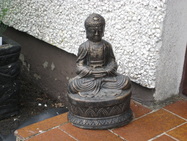 June's Smiling Buddha Nowhere has the contrasts in a country been so evident than during our visit to Northern Ireland. Nowhere have we seen such separation between people and yet nowhwere have we been given so much love. A warm thank you goes to June and John, Iain’s parents, who cooked wonderful meals for us, took us on hikes in the area, and shared their stories with us. See the wonderful pics of the sunny days we had at Giant’s Causeway, Mussenden temple, Carrick-a-Rede rope bridge and more here: http://flic.kr/s/aHsjAF5GrA
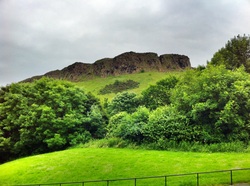 Arthur's Seat After York, we passed the ancient Roman Hadrian’s wall into the territory the Romans labeled “too barbarian for settlement” at the dawn of the first millennium. Scotland is actually an island which only recently (in geological time) crashed into England after starting millions of years ago at the South Pole before moving north past the equator and finally ending up in its current location in the North Sea. This travel transformed the land through ages of lush forests, arid deserts, and bubbling volcanoes. The resulting landscape is stunning. We started our tour of the country in the capital city of Edinburgh. The city’s namesake castle is nestled atop an extinct volcano while in the city proper narrow allies shoot down the streets offering endless exploration. We caught up on history at the wonderful Museum of Scotland and walked along the coastline to the tiny village of Cramond while staying on the seaside with our CS hosts Katey and Nick. We also hiked to the top of the city’s other extinct volcano, Arthur’s seat, for beautiful views of the surrounding area. Finally, we immersed ourselves in the Knights Templar and Christian paganism with a visit to Rosslyn Chapel, made uberfamous (and ubercrowded) by the Da Vinci Code novel and movie. From Edinburgh we decided to relax on the constant planning and booked a 5 day tour of the highlands with a company called MacBackpackers. The tour was an amazingly in-depth experience with our guide Neil telling us wonderful stories of Scottish history and folklore while leading us on hikes throughout the highlands. Our first day saw us visiting the William Wallace monument before traveling through Glencoe, a beautiful mountainous region haunted by the massacre of the MacDonald Clan there over 300 years ago. 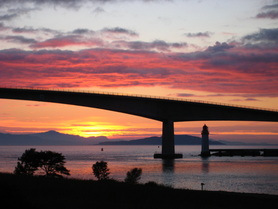 Sunset at Skye Bridge From Glencoe, we headed to the “winged” Isle of Skye on the west coast of Scotland - one of the most beautiful islands in the world and origin of the Clan McLeod (a name I have loved since watching the Highlander Movies as a kid!). Here we heard stories of the Scottish Warrior Queen Scáthach and her enchanted creek, Cú Chulainn the Invincible and his always true spear, the Old Man of Storr and how he was tricked into dancing on a Sunday, and the Giants grand party at McLeod’s table which led to Arthur’s seat being thrown to Edinburgh. We also heard of the magical creatures in faire glen, and how they fled for better fortunes in distant lands as humans slowly stopped believing in them. All these myths were only bested by the landscape, which strikes awe into even the most cynical soul. High above the Quiraing in Skye, Neil showed us how to make a broken spector, a phenomenon where the sun’s rays shining behind you shoots your shadow onto the clouds below and shrouds your shadow in a glorious rainbow. Together we waved, basking in this brief ascent towards heaven. This glimpse of our inner divinity got me thinking about the age old practice of confession. While today the word confession holds strong religious connotations that may turn off many, it is a concept that should not be lost to time like the fairies. Reb Anderson, one of the teachers in the Suzuki Zen Lineage who we studied with, reiterated the importance of confession as a way to unveil the blind spots of the ego that cause so much pain for ourselves and others. These blind spots are usually ingrained patterns that we don't notice easily, but that others do. If others bring them to your attention, they can be used as points of awareness in the future. Also, when you inevitably repeat the same mistakes (we are human after all), the act of confessing them to a friend, loved one, or a teacher, brings awareness to them and invites that person to help you bring awareness to these patterns. Bringing these habits out of the dark and into the light of awareness is the beginning of freedom and crucial to any spiritual practice. At faire glen, there is an ancient spiral formation below the faire castle (see above picture) where a unique opportunity for confession arose. Legend has it that you can walk into the spiral while confessing the aspects of your personality that cause pain for yourself and others. You then walk out of the spiral while affirming your intent to be aware of those aspects of yourself and to behave in a different way. If you do this wholeheartedly, it is said that the negative energy will be left in the center of the spiral. 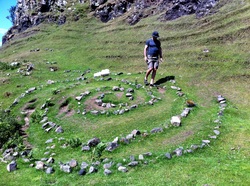 I walked the spiral, and I can’t say for sure if my negative energy was left behind. But in the spirit of confession I just spoke about, I decided to share my walk through the spiral with you. As I walked inwards, I said, “sharpness in tone, interrupting others, eating my food too fast, being critical of others, complaining, and diminishing life through worry.” As I walked outwards I said, “speak gently, chew slowly, be generous in word and action, remember that life is only in a hurry if you are.” I must admit that as I walked away from the spiral, I felt certain lightness in my step and in my heart. Was it from the spiral or from the powerful act of confession? Or both? The rest of the highlands were as wonderful as Skye, though time doesn’t permit me to elaborate on everything. In brief summary, we hiked through 8,000 year old forests over Loch Marie, learned the Scottish dance Strip the Willow in the lively bars of Inverness, and mourned the Highland Clearances that would come after the pivotal battle of Culloden. After that we visited a local scoth whisky distillery, an old aristocratic nature park called the Hermitage, 8,000 year old standing stones from a lost civilization and the beautiful town of St. Andrews with its old castles, cathedrals, and the creation of modern day golf. Neda and I found our trip through Scotland to be tremendously moving at a spiritual, aesthetic, and cultural level. See all the wonderful pics of our journey through this land here: http://flic.kr/s/aHsjAxNY1s
London is the largest city we visited during this part of the trip and it’s steeped in history and culture. A part of this history, the Tower of London stands along the River Thames and is a reminder of the militant past of Britain’s rulers. William the Conqueror built the core of the tower in 1078 when he invaded from Normandy and took over the British crown. The tower was originally erected to pacify the city’s population and establish his authority as King. While this bit of history is interesting, what really fascinated me was William’s changing identity. As a Norman he was a Frenchman, but his recent ancestry had come from Vikings who had invaded France years earlier. The French King Charles the Simple thought the best way to deal with this constant threat was to simply grant land titles to the invaders, thus creating new defenders of the territory (thus the name Normandy, from Norsemen or “North Men”). All of this history made us start to question identity in general. I always naively thought that the British Monarchy was an unbroken bloodline going back thousands of years when in fact just 1,000 years ago it was essentially taken over by Viking blood. Then, in 1714, George the Elector of Hanover became King, giving the crown the primarily German blood it retains even today (Queen Elizabeth comes from this line). 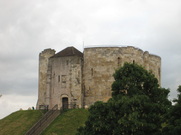 Clifford's Tower in York This inquiry into identity was heightened during our visit to York, when I saw that in York around 1190, my identity as a Jewish person would have seen me burned in Clifford’s Tower due to the capricious desires of a mob envious of perceived wealth and eager to wipe out their debts. These examples of how identity can be used to claim power over people’s lives (in the case of the Monarchy) or the right to claim another’s life (in the case of the Jews) proves what a destructive concept it can be. It is useful to define ourselves in relation to others for the purposes stimulating creative thought and giving us a lens to interpret the world. But we must recognize that this lens is simply a mental fabrication that our ego uses as it sees fit to get what it wants. With this understanding, we can start to be less attached to our identity. This doesn’t mean we don’t appreciate who we are, but it does mean that we don’t take that concept so seriously that it causes pain for others. In a more practical sense, it felt wonderful to appreciate a part of my identity and see my cousin Amanda and her husband Sean in York after nearly a year of seeing no family from my side. York contains the buried Viking city of Jorvik that came to be when the Vikings conquered York and lived there from 875 to 954. It also has ancient Roman walls, haunted pubs, and beautiful churches to explore. The rest of our trip to London (before York) brought us a wonderful day with our friends Jeff & Karen from Austin, a visit by Neda to ancient Stonehenge, and beautiful walks around the city as it prepares for the Olympics.
|